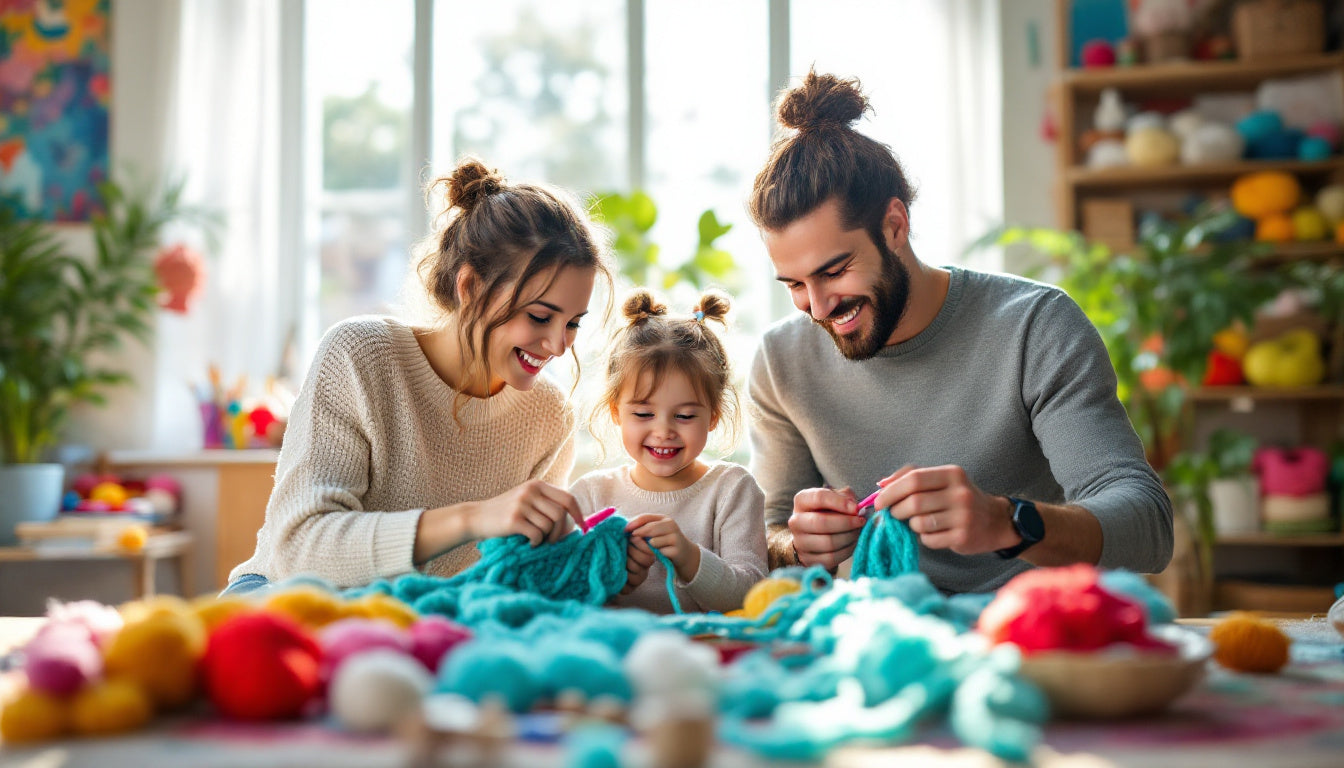
Save Yarn and Crochet Smarter: Top Tips to Elevate Your Projects!
Crocheting is a relaxing and creative hobby, but it can be frustrating when your yarn supply runs out faster than expected. For beginners and seasoned crocheters alike, learning to use yarn more efficiently can save money and reduce waste, while also being more eco-conscious. Simple strategies, like adjusting your tension or choosing the right stitches, can make all the difference. Explore practical ways to maximize yarn efficiency and take your crochet projects further.
Understanding Yarn Consumption in Crochet
To create beautiful, lasting crochet pieces while maximizing yarn efficiency, it’s crucial to understand how different techniques impact your yarn usage. Whether you're experimenting with new stitches, managing tricky patterns, or avoiding common mistakes, becoming savvy about yarn consumption can save you both time and frustration.
How Different Stitches Affect Yarn Usage
Certain crochet stitches naturally consume more yarn than others. For example, dense stitches like bobble stitches or post stitches often use more yarn due to their texture and thickness. Why? These stitches stack or layer yarn, creating a bulkier result.
On the flip side, simpler stitches such as single crochet (SC) or chain stitches tend to use less yarn because they aren’t as textured. Here's a general rule of thumb: the taller or more complex the stitch, the more yarn you’ll likely need.
If you're planning a yarn-saving project, you may want to stick to basic stitch patterns, keeping them simple like double crochet (DC) or granny square motifs. Take a look at the Which Craft Uses More Yarn: Crochet or Knitting? post for more insights into stitch efficiency.
Common Crochet Mistakes That Waste Yarn
You may be surprised to learn how easily some habits can waste yarn. Here are a few common pitfalls to avoid:
- Improper Tension: Crocheting too tightly not only strains your hands but also eats up more yarn. Loose, even tension makes for smoother and more efficient stitching.
- Frequent Frogging: Repeatedly pulling out your stitches because of errors can damage yarn fibers and result in wasted, unsalvageable yarn.
- Overly Long Yarn Tails: Leaving excess yarn when starting or finishing a project might seem inconsequential but can add up over time. Aim for a tail length of just 4-6 inches for weaving.
By addressing these mistakes, you’ll not only save yarn but also enjoy smoother projects overall.
The Role of Patterns in Yarn Management
Patterns play a key role in determining how much yarn you’ll need. Complicated patterns with intricate detailing or small motifs often demand more yarn than simpler alternatives.
Tips for choosing yarn-efficient patterns:
- Look for patterns with a noted yarn usage estimate. This can help you gauge if it’s manageable with your available stash.
- Opt for openwork designs like lace or mesh – these require fewer stitches and use less yarn.
- Skip patterns that focus heavily on embellishments like appliques or layered colorwork, which can quickly increase yarn consumption.
For a practical guide on pattern selections and yarn-saving strategies, head to crochet pattern guides within Tips, Tricks & Reviews.
Understanding these factors can help you plan projects efficiently, maximizing your yarn investment while allowing room for creativity.
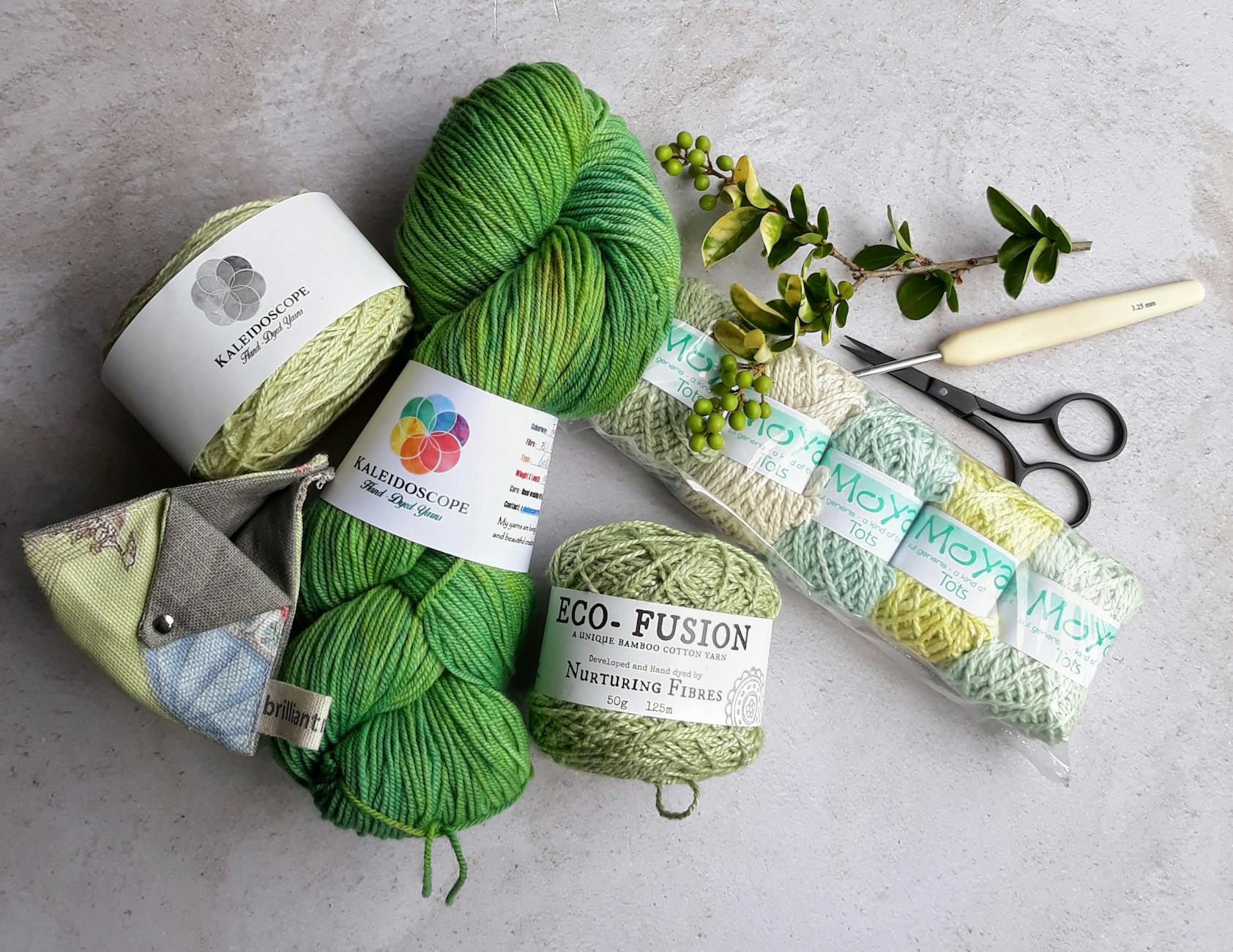
Photo by Surene Palvie
Choosing the Right Yarn for Maximum Efficiency
Finding the perfect yarn for your crochet projects isn’t just about aesthetics—it's a key factor in optimizing your time, effort, and resources. The right yarn can make or break your results, both in terms of quality and cost-effectiveness. Let’s explore how to make informed decisions when selecting yarn, focusing on weights, fiber content, and durability.
Yarn Weights and Their Impact
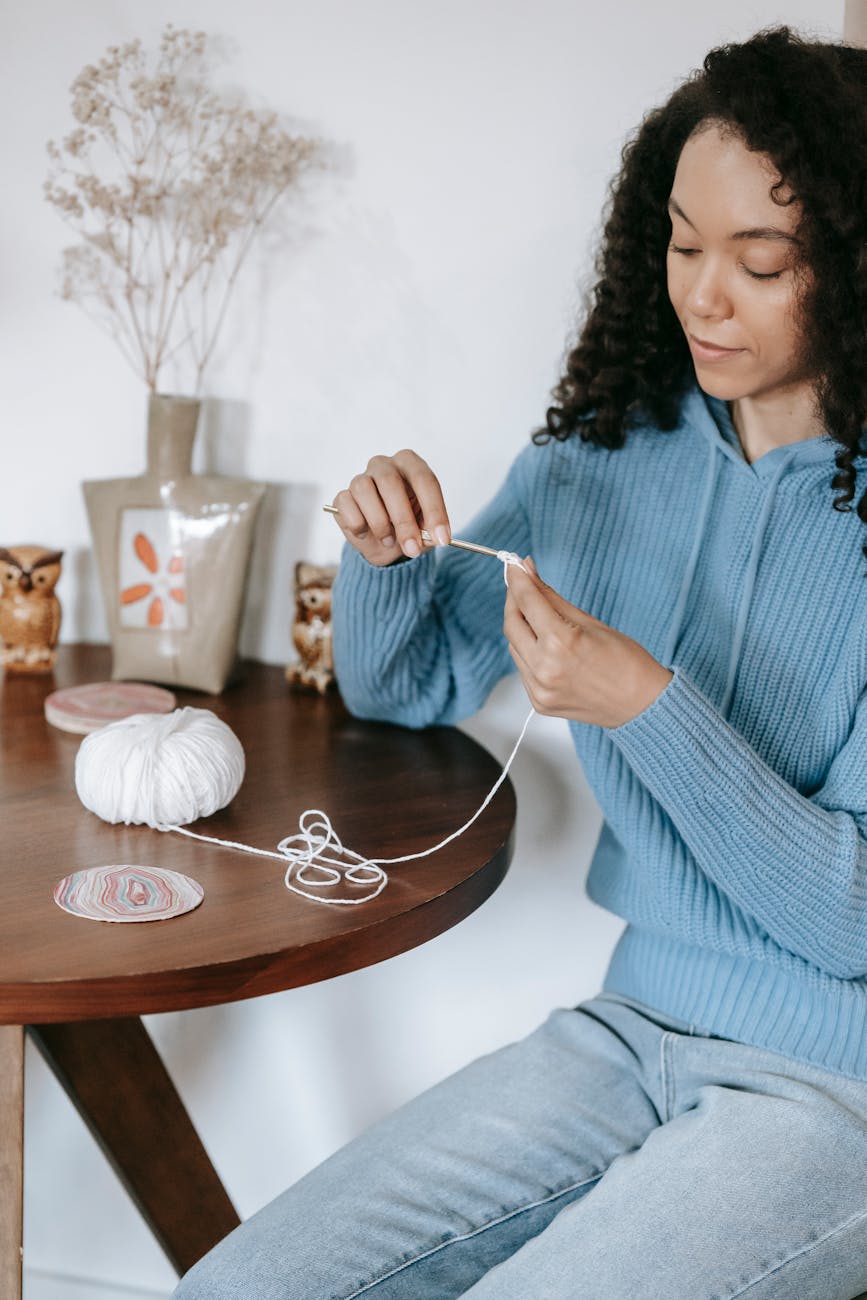
Photo by Miriam Alonso
Yarn weight directly impacts the amount of yarn needed for your project and how quickly you can complete it. Choose wisely to avoid unnecessary wastage.
- Lightweight Yarns (e.g., DK, Sport): Great for thinner projects like garments or table linens. These yarns are efficient due to their minimal bulk but can extend crochet time.
- Medium-Weight to Bulky Yarns: Ideal for projects like blankets or scarves. They generally require fewer stitches, which speeds up the process and minimizes yarn usage.
- Super Bulky Yarns: These are less efficient in the strictest sense since they consume more material for their volume. However, their speed in stitching makes them perfect for quick, chunky projects.
When selecting weights, think about your project’s functionality and timeline. Investing a little time upfront in research can save you yards of frustration. For more, check out the Posts Tagged: Yarn Craft Hacks.
How Fiber Content Affects Yarn Usage
Did you know that your yarn's material can significantly affect its efficiency? While the fiber type won’t change the amount of yarn a project requires, it does influence how the finished product feels and holds up over time.
Natural Fibers:
- Pros: Breathable, durable, and often softer. They're ideal for wearables or items requiring longevity. Cotton and wool are classic examples.
- Cons: Usually pricier and can stretch over time (in some cases, unpredictably). Wool tends to felt, which may not work for all designs.
Synthetic Fibers:
- Pros: Affordable, lighter, and available in a broad selection of colors. Acrylic yarns are great for budget projects or those with heavy use.
- Cons: Tend to degrade faster compared to their natural counterparts and may not offer the same luxurious feel.
A blend of natural and synthetic fibers can strike a good balance between cost and performance for many crocheters. Refer to Choosing the Best Yarn for Knitting and Crochet Projects for more insights.
Identifying High-Quality Yarn That Lasts
Not all yarn is created equal—some are prone to pilling, snapping, or losing color after just a few uses. Here's how to spot yarn that'll go the distance:
- Inspect for Tight Twists: Loose or barely spun fibers often lead to quicker wear and tear.
- Check the Label: Look for key details like tensile strength or anti-pilling treatments; these are your cues for longevity.
- Feel the Yarn: Run it through your fingers. If it feels rough or overly fluffy, it may wear down faster during crocheting.
If longevity is your priority, choose brands known for quality. Premium yarn often costs a bit more upfront but saves you money over time since you’ll use less to replace damaged or worn-out pieces. Explore more tips on yarn life and efficiency in Tips, Tricks & Reviews on Crochet Patterns.
By focusing on weight, fiber type, and quality, you can make smarter yarn decisions and create stunning crochet projects with maximum efficiency.
Techniques to Improve Yarn Efficiency
Learning how to maximize your yarn's potential can save both time and money as well as ensure smoother crochet projects. Even minor adjustments in your technique can make a significant difference. Let’s look at some practical tips to improve your yarn efficiency.
Maintaining Consistent Tension
Tension isn't just about maintaining neat stitches—it also determines how much yarn you use. Consistent tension means less yarn wasted, smoother stitches, and projects that fit as intended.
When you're crocheting, think of your tension like the steady rhythm of a drumbeat: keep it even and predictable. Uneven tension creates flaws that might force you to frog (undo stitches) or use more yarn than necessary. If you're struggling, try adjusting your crochet grip or experimenting with different hook materials—metal hooks often allow yarn to glide more smoothly.
For more tips, check out How to Crochet for Beginners for insight on posture and grip that promote consistent tension.
Using the Correct Hook Size
Using the wrong hook size for your project can result in inefficient yarn usage. A hook that's too large will make your stitches loose and require more yarn, while a smaller hook can lead to tight stitches and even hand strain. Always match your hook size to your yarn’s weight and the pattern's recommendation.
When in doubt, create a small swatch before committing. This allows you to test whether the hook size complements your chosen yarn and pattern. Remember, a slight modification in hook size can make a big difference in the final outcome. Want to learn more about yarn efficiency? Explore 35 Cool Crochet Hacks Every Crocheter Should Know.
Here’s a thoughtful analogy: think of your hook like a steering wheel—it directs the flow of yarn. When it’s the right size, you’ll drive through your work effortlessly and smoothly.

Photo by Los Muertos Crew.
Mastering the Art of Frogging
Frogging, or ripping out stitches, is sometimes unavoidable, but it doesn’t have to damage your yarn. Using proper frogging techniques can reduce unnecessary waste and maintain the integrity of the fibers.
Here’s how to frog effectively:
- Work Slowly: Haste can cause yarn to split or tangle.
- Unwind Methodically: Don't tug at the yarn—guide it gently back into a smooth skein.
- Avoid Stretching: Overstretched yarn loses elasticity and looks worn out in future projects.
Keeping your yarn in good condition is essential for aesthetic and functional longevity. For advanced frogging tips, check out this engaging read on crochet efficiency.
Joining Yarn Without Waste
There will inevitably come a time when your skein runs out mid-project. The good news? Yarn joining doesn’t have to leave behind wasteful scraps. Using seamless techniques minimizes leftovers while keeping your project tidy.
Popular and efficient yarn-joining methods include:
- Russian Join: Perfect for adding a new skein invisibly—securing two ends together without knots.
- Magic Knot: A quick, strong option for joining that won't unravel, but trim carefully to avoid fraying.
- Weaving Ends As You Go: This saves time and eliminates scraps altogether.
Each method has its pros and cons depending on the project, so practice these techniques to find what suits you best. To further optimize your resources, visit the yarn hacks blog.
By focusing on small, intentional changes in these areas, you'll notice improvements in your yarn efficiency and crochet performance.
Organizing and Storing Yarn Smartly
Whether you're a seasoned crocheter or just starting out, keeping your yarn collection organized ensures you spend more time crocheting and less time untangling. Smart yarn organization also prevents waste and enhances the durability of your stash.
The Best Way to Store Yarn Properly
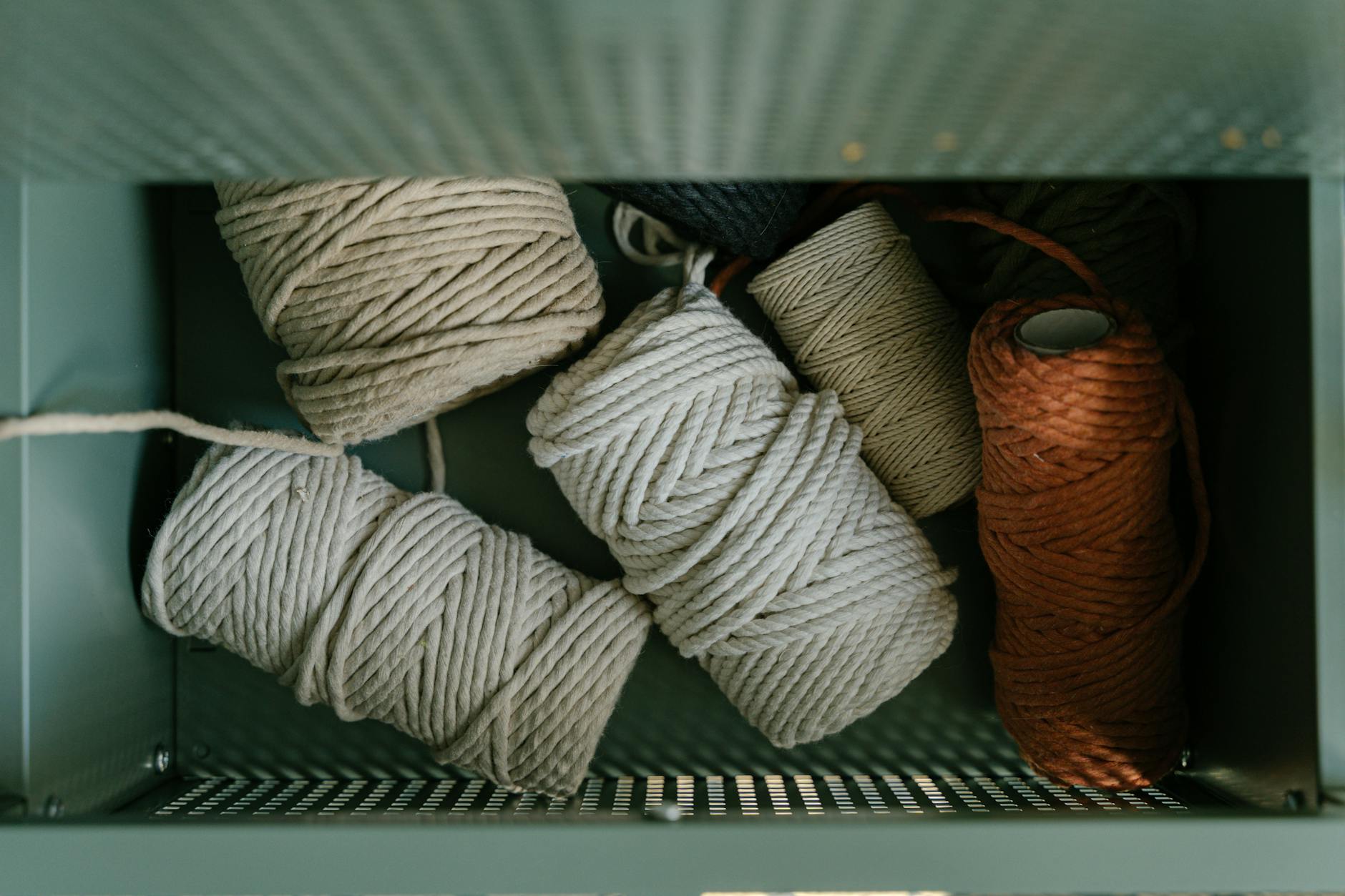
Photo by Antoni Shkraba
Storing yarn correctly isn't just about keeping things tidy; it's about preserving the quality and usability of your fibers. Here are some actionable tips to maintain your yarn stash:
- Avoid Tangles: Use rolling storage bins or repurposed wine racks to neatly organize skeins by color or type. This minimizes the dreaded "yarn barf" (knots or clumps). Learn more creative storage techniques at Smart Yarn Storage Solutions for Crafters.
- Prevent Dust and Moisture: Store your yarn in airtight containers to avoid exposure to elements that can degrade fibers over time, such as humidity or pests.
- Keep It Visible: Transparent storage bins or shelves make it easy to see your stash at a glance, which leads to better planning for your projects.
Taking small steps to protect your yarn ensures it’s ready whenever inspiration strikes.
Label Preservation for Yarn Details
Yarn labels are like an instruction manual and resource guide rolled into one. They include vital information, such as yarn weight, fiber content, recommended hook size, and, most importantly, the dye lot—essential for color matching in large projects.
How can you save these vital references?
- Use Ziplock Bags: Place each skein with its label inside a ziplock to keep everything intact.
- Binder Rings: Thread labels onto a small ring for organized reference once skeins are unwound.
- Scrapbooking Style: Create a yarn logbook where you paste labels and jot down project details.
Preserving your labels doesn’t just keep you organized—it ensures you never get mismatched colors halfway through!
For more tips, read Setting Up a Comfortable Crochet Workspace.
Reusing Scrap Yarn Effectively
Scraps don’t need to be waste—they often hold the potential to become something incredible. Here’s how to put your leftover yarn to good use:
- Mini Projects: Use scraps to create small items like coasters, keychains, or amigurumi details.
- Colorful Borders: Add a pop of color to blankets, scarves, or hats using leftover yarn for an eye-catching border.
- Practice Swatches: Perfect a new stitch or technique without unwinding fresh skeins.
Scrap-friendly projects can also help you experiment with colors and textures. Explore more ideas at yarn organization on Podcasts.
Organizing your yarn stash and crafting creatively with leftovers not only saves resources but also adds a layer of sustainability and mindfulness to your craft.
Budget-Friendly Tips for Buying Yarn
Yarn shopping can be as overwhelming as it is exciting, especially when you're on a budget. Whether you're making a cozy blanket or crafting delicate doilies, finding affordable yarn options without sacrificing quality is essential. Let’s dive into a few clever strategies to keep your yarn spend under control.
Shopping During Yarn Sales

Photo by Helena Jankovičová Kováčová
Timing is everything when it comes to yarn sales. Many retailers offer significant discounts during specific times of the year, such as after the holidays or during seasonal clearance events. Watch for annual sales like Black Friday, end-of-summer clearouts, or back-to-school promotions.
Keep this in mind while shopping:
- Sign Up for Newsletters: Many yarn brands and craft stores share exclusive sales and coupons via email.
- Social Media Accounts: Follow your favorite retailers on Instagram or Facebook for flash sales.
- Stack Coupons: Some places allow you to combine discounts, maximizing your savings.
- Local Yarn Shops (LYS): These often have clearance baskets with hidden gems.
For more affordable shopping ideas, check out Cheap Yarn Shopping Tips on Secret Yarnery.
Buying Yarn in Bulk
If you're serious about saving money, buying yarn in bulk might just be your best option. Stores often offer discounts when purchasing larger quantities, especially online. This strategy works well if you're planning multiple projects or using the same type of yarn a lot.
Benefits of Bulk Buying:
- Lower Price Per Skein: Multipacks generally cost less per skein than individual purchases.
- Ready for Big Projects: No scrambling for matching dye lots halfway through!
- Reduced Shipping Costs: Ordering in bulk often qualifies for free shipping.
However, be cautious:
- Upfront Cost: Bulk buying requires more cash upfront, so plan accordingly.
- Storage Needs: You’ll need space to store extra yarn without risking damage from damp or pests.
Stores like craft warehouse outlets or online retailers often have deals specifically for bulk buys. According to threads on Reddit’s crochet community, bulk packs are lifesavers for anyone attempting sizeable crochet projects like afghans.
Utilizing Second-Hand Yarn Sources
For the environmentally conscious or truly thrifty, second-hand yarn is a fantastic option. It’s a bit like treasure hunting—you never know what you’ll find! Here are some great places to look for pre-loved yarn:
- Thrift Stores: Many charity shops have sections for craft supplies, where gently used (or never-used) yarns end up.
- Online Marketplaces: Websites like Facebook Marketplace or eBay often have bundles of used yarn at great prices.
- Craft Swaps: Some communities host local meetups or online forums where crafters exchange materials they no longer need.
- Estate Sales: These can be goldmines for acquiring large yarn stashes at a fraction of the cost.
By sourcing second-hand, you're not only saving money but also helping reduce waste in the crafting world. Additionally, some sites, such as I Like Crochet, explore ways to creatively organize your second-hand stash.
Spending wisely doesn’t mean compromising on quality. With a little effort and clever planning, you can build an impressive yarn collection and save cash for more crochet adventures.
Eco-Friendly Crochet Practices
Crocheting sustainably allows you to channel your creativity while reducing waste and being kind to the Earth. By focusing on eco-friendly practices, every stitch you make can contribute to a greener planet. Whether you’re an experienced crocheter or just starting, here are steps to make eco-conscious choices in your projects.
Avoiding Single-Use Projects: Encourage readers to focus on creating durable, reusable items
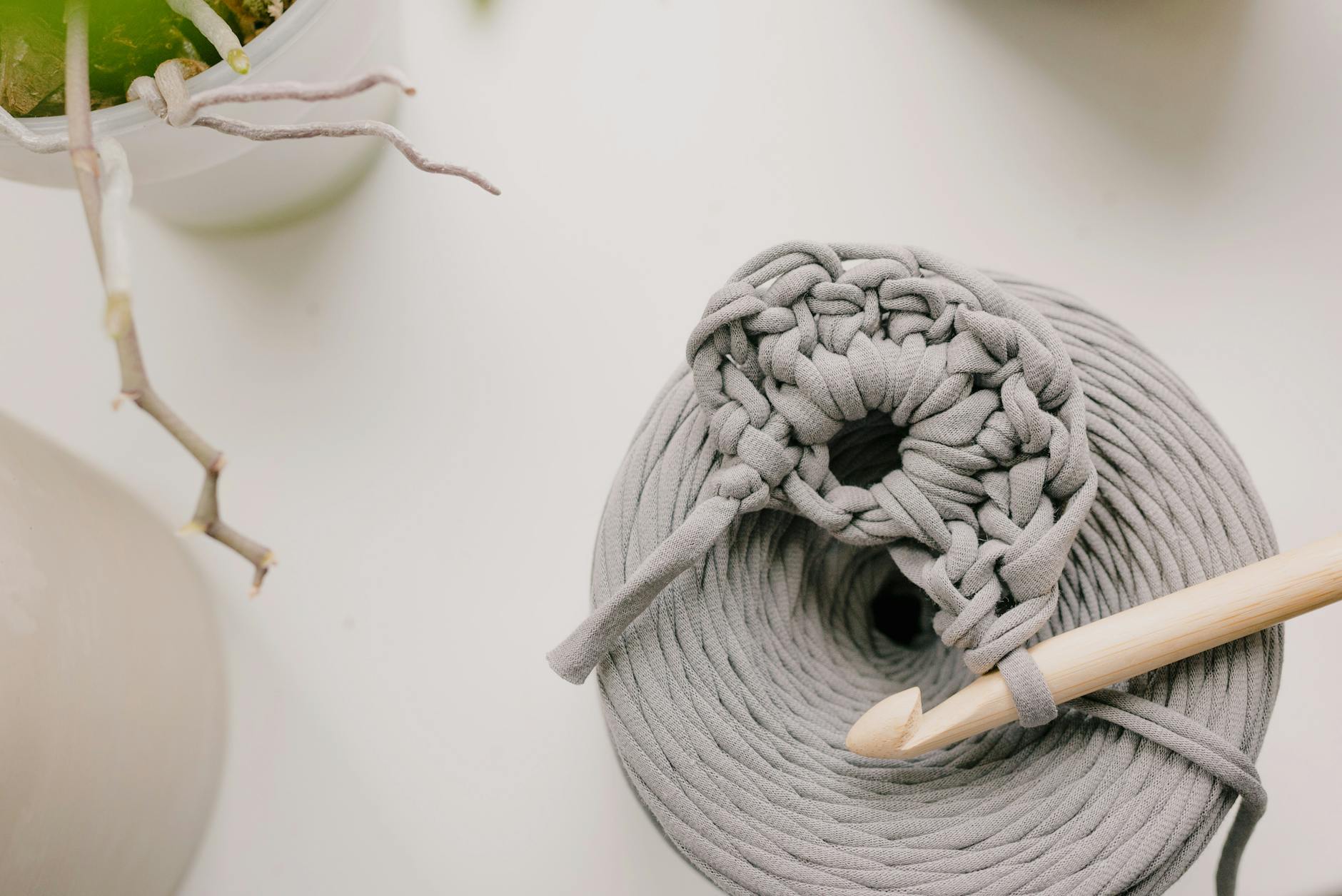
Photo by Ksenia Chernaya
Creating durable items reduces the need for constant replacements, helping avoid waste. Instead of quick single-use projects, challenge yourself to make crochet pieces that provide long-term utility. For instance:
- Swap out disposable paper towels with crocheted cotton dishcloths.
- Make sturdy market tote bags to replace plastic grocery bags.
- Create reusable gift wraps or pouches for a charming, eco-friendly alternative to wrapping paper.
Projects like these are not only sustainable but also incredibly practical. They often inspire admiration, showcasing both your creativity and commitment to reducing waste. For ideas on easy, useful beginner projects, check out Top 5 Easiest Things to Crochet for Beginners.
Need inspiration? Explore sustainable patterns that encourage reusability, such as those featured on Green Fox Farms Designs.
Upcycling Projects with Old Yarn: Share ideas for reusing yarn from previous projects creatively
Reusing old yarn can breathe new life into your creations while minimizing waste. Yarn from past projects, or even those lying forgotten in your stash, can be upcycled into fresh ideas. Here's how you can work some magic with leftovers:
- Patchwork Designs: Combine small amounts of different yarns to make colorful blankets, scarves, or coasters. Think of patchwork as a crochet artist’s canvas—it’s all about blending diverse elements harmoniously.
- Accent Pieces: Use old yarn for stripes, trim, or decorative elements on your projects to add pops of color and texture.
- Amigurumi Projects: Small stuffed toys and characters are perfect for using up scrap yarn without requiring full skeins.
When reusing yarn, remember to properly “frog” old pieces (undo stitches) to preserve the integrity of the fibers. For guidance on vibrant eco-friendly designs and patterns, check out Earth Day: Eco-Friendly Crochet Ideas and Free Patterns.
Practicing these simple steps empowers you to crochet sustainably, reducing your crafting footprint while making meaningful creations.
Conclusion
Maximizing yarn efficiency in crochet isn’t just about saving resources—it’s about crafting smarter with intention. By adopting practical tips like choosing efficient stitches, avoiding common mistakes, and using the right yarn and tools, you can stretch your materials further while enjoying seamless creativity.
Start experimenting with these strategies today to see the difference in your projects, your budget, and even your environmental impact. For more detailed insights and time-saving ideas, visit Tips, Tricks & Reviews Tagged "Crochet Tips" or check out inspiring crochet tutorials on The Secret Yarnery's YouTube channel.
What tips will you try first? Let us know your go-to methods for efficient crocheting below! Every small step leads to smarter crafting.
FAQs
1. How can I reduce yarn waste while crocheting?
To minimize waste, focus on maintaining consistent tension, using the right hook size, and avoiding overly long yarn tails. Incorporate techniques like weaving in ends as you go or using seamless yarn-joining methods, such as the Russian Join.
2. Which crochet stitches use the least yarn?
Simpler stitches like single crochet (SC), chain stitches, or double crochet (DC) use less yarn compared to more textured options like bobble or post stitches. Openwork patterns like lace or mesh are also great for saving yarn.
3. How can I store my yarn properly to prevent damage?
Store your yarn in airtight containers to protect it from dust, moisture, and pests. Organized storage solutions, such as transparent bins or shelves, help you see your stash easily and avoid unnecessary purchases.
4. What can I do with leftover yarn scraps?
Leftover yarn can be used for small projects like coasters, keychains, or as accents in larger projects. Scrap yarn is also perfect for practicing new stitches or experimenting with patchwork designs like blankets or scarves.
5. How do I join new yarn seamlessly?
Methods like the Russian Join or Magic Knot are ideal for seamlessly adding new yarn without leaving bulky or visible joins. Practice these techniques to ensure smooth, professional finishes in your projects.
6. What yarn type is most efficient for beginners?
Medium-weight yarns (like worsted weight) are beginner-friendly because they are versatile, easy to work with, and require fewer stitches than lightweight yarns. They also strike a balance between efficiency and durability.
7. Are natural or synthetic yarns better for saving resources?
Both have pros and cons. Natural fibers (like cotton or wool) are durable but can be pricier. Synthetic fibers (like acrylic) are budget-friendly and lightweight but may degrade faster. Blended yarns offer a good compromise between cost and durability.
8. What eco-friendly practices can I adopt while crocheting?
Focus on reusable or long-lasting projects like market bags, dishcloths, and gift wraps. Use second-hand or upcycled yarn and choose patterns that minimize waste. Properly storing and reusing scraps can also add to sustainability.
9. How do I plan my projects to avoid running out of yarn?
Choose patterns that provide yarn usage estimates and ensure you calculate your yarn needs before starting. Purchase extra yarn from the same dye lot to account for errors or adjustments.
10. How do I keep my crochet tension even?
Experiment with different grips, adjust your hand positioning, or switch to hooks made of varying materials to find what works for you. Practice regularly and create small swatches to test and improve your tension.
Christa Patel is a dedicated crochet artist, instructor, and writer who has spent over a decade mastering the craft and sharing her knowledge with the crochet community. Her passion lies in creating sustainable and budget-friendly projects that inspire both beginners and seasoned crafters alike.
Through her engaging tutorials, practical tips, and creative patterns, Christa aims to make crocheting accessible and enjoyable for everyone. Known for her thoughtful approach to yarn efficiency and eco-conscious crafting, she encourages crocheters to embrace mindful techniques that reduce waste and promote sustainability.
When she's not busy with her crochet hook, Christa enjoys exploring new yarn shops, experimenting with innovative patterns, and connecting with fellow creators. Follow Christa Patel here for more crochet tips, patterns, and inspiration!


